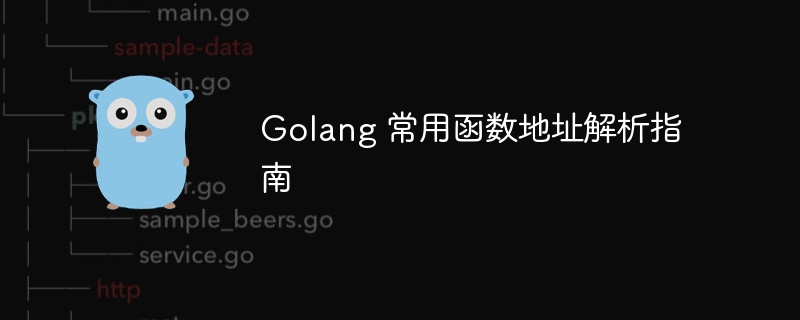Golang common function address resolution guide
Apr 08, 2024 pm 02:18 PMThe key functions for parsing addresses in the Go language include: net.ParseIP(): Parse IPv4 or IPv6 addresses. net.ParseCIDR(): Parse CIDR tags. net.ResolveIPAddr(): Resolve hostname or IP address into IP address. net.ResolveTCPAddr(): Resolve hostnames and ports into TCP addresses. net.ResolveUDPAddr(): Resolve hostnames and ports into UDP addresses.

GoLang Common Function Address Resolution Guide
In the Go language, address resolution is a basic operation in network programming. This article will introduce commonly used functions in the Go language to parse addresses, and provide practical cases to demonstrate how to use these functions.
Core functions
-
net.ParseIP(): Parse a string into an IPv4 or IPv6 address. Usage:
ip := net.ParseIP("192.168.0.1") -
net.ParseCIDR(): Parse the string into a CIDR tag, including IP Address and mask length. Usage:
cidr := net.ParseCIDR("192.168.0.0/24") -
net.ResolveIPAddr(): Resolve the host name or IP address into a IP address. Usage:
addr, err := net.ResolveIPAddr("ip", "google.com") -
net.ResolveTCPAddr(): Resolve the host name and port is a TCP address. Usage:
addr, err := net.ResolveTCPAddr("tcp", "google.com:80") -
net.ResolveUDPAddr(): and
ResolveTCPAddr()Similar, but for UDP addresses. Usage:addr, err := net.ResolveUDPAddr("udp", "google.com:80")
##Actual case
Case 1: Parsing IPv4 address
package main
import (
"fmt"
"net"
)
func main() {
ip := net.ParseIP("192.168.0.1")
fmt.Printf("IP: %v\n", ip)
}Output:
IP: 192.168.0.1
Case 2: Parsing CIDR tag
package main
import (
"fmt"
"net"
)
func main() {
cidr := net.ParseCIDR("192.168.0.0/24")
fmt.Printf("CIDR: %v\n", cidr)
}Output:
CIDR: 192.168.0.0/24
Case 3: Resolving hostname
package main
import (
"fmt"
"net"
)
func main() {
addr, err := net.ResolveIPAddr("ip", "google.com")
if err != nil {
fmt.Printf("Error: %v\n", err)
} else {
fmt.Printf("IP: %v\n", addr.IP)
}
}Output:
IP: 172.217.2.142
The above is the detailed content of Golang common function address resolution guide. For more information, please follow other related articles on the PHP Chinese website!

Hot AI Tools

Undress AI Tool
Undress images for free

Undresser.AI Undress
AI-powered app for creating realistic nude photos

AI Clothes Remover
Online AI tool for removing clothes from photos.

Clothoff.io
AI clothes remover

Video Face Swap
Swap faces in any video effortlessly with our completely free AI face swap tool!

Hot Article

Hot Tools

Notepad++7.3.1
Easy-to-use and free code editor

SublimeText3 Chinese version
Chinese version, very easy to use

Zend Studio 13.0.1
Powerful PHP integrated development environment

Dreamweaver CS6
Visual web development tools

SublimeText3 Mac version
God-level code editing software (SublimeText3)
 Golang vs. C : Performance and Speed Comparison
Apr 21, 2025 am 12:13 AM
Golang vs. C : Performance and Speed Comparison
Apr 21, 2025 am 12:13 AM
Golang is suitable for rapid development and concurrent scenarios, and C is suitable for scenarios where extreme performance and low-level control are required. 1) Golang improves performance through garbage collection and concurrency mechanisms, and is suitable for high-concurrency Web service development. 2) C achieves the ultimate performance through manual memory management and compiler optimization, and is suitable for embedded system development.
 Golang and C : Concurrency vs. Raw Speed
Apr 21, 2025 am 12:16 AM
Golang and C : Concurrency vs. Raw Speed
Apr 21, 2025 am 12:16 AM
Golang is better than C in concurrency, while C is better than Golang in raw speed. 1) Golang achieves efficient concurrency through goroutine and channel, which is suitable for handling a large number of concurrent tasks. 2)C Through compiler optimization and standard library, it provides high performance close to hardware, suitable for applications that require extreme optimization.
 Golang vs. Python: Performance and Scalability
Apr 19, 2025 am 12:18 AM
Golang vs. Python: Performance and Scalability
Apr 19, 2025 am 12:18 AM
Golang is better than Python in terms of performance and scalability. 1) Golang's compilation-type characteristics and efficient concurrency model make it perform well in high concurrency scenarios. 2) Python, as an interpreted language, executes slowly, but can optimize performance through tools such as Cython.
 Golang vs. Python: Concurrency and Multithreading
Apr 17, 2025 am 12:20 AM
Golang vs. Python: Concurrency and Multithreading
Apr 17, 2025 am 12:20 AM
Golang is more suitable for high concurrency tasks, while Python has more advantages in flexibility. 1.Golang efficiently handles concurrency through goroutine and channel. 2. Python relies on threading and asyncio, which is affected by GIL, but provides multiple concurrency methods. The choice should be based on specific needs.
 Golang vs. Python: The Pros and Cons
Apr 21, 2025 am 12:17 AM
Golang vs. Python: The Pros and Cons
Apr 21, 2025 am 12:17 AM
Golangisidealforbuildingscalablesystemsduetoitsefficiencyandconcurrency,whilePythonexcelsinquickscriptinganddataanalysisduetoitssimplicityandvastecosystem.Golang'sdesignencouragesclean,readablecodeanditsgoroutinesenableefficientconcurrentoperations,t
 Golang and Python: Understanding the Differences
Apr 18, 2025 am 12:21 AM
Golang and Python: Understanding the Differences
Apr 18, 2025 am 12:21 AM
The main differences between Golang and Python are concurrency models, type systems, performance and execution speed. 1. Golang uses the CSP model, which is suitable for high concurrent tasks; Python relies on multi-threading and GIL, which is suitable for I/O-intensive tasks. 2. Golang is a static type, and Python is a dynamic type. 3. Golang compiled language execution speed is fast, and Python interpreted language development is fast.
 Choosing Between Golang and Python: The Right Fit for Your Project
Apr 19, 2025 am 12:21 AM
Choosing Between Golang and Python: The Right Fit for Your Project
Apr 19, 2025 am 12:21 AM
Golangisidealforperformance-criticalapplicationsandconcurrentprogramming,whilePythonexcelsindatascience,rapidprototyping,andversatility.1)Forhigh-performanceneeds,chooseGolangduetoitsefficiencyandconcurrencyfeatures.2)Fordata-drivenprojects,Pythonisp
 Golang: From Web Services to System Programming
Apr 20, 2025 am 12:18 AM
Golang: From Web Services to System Programming
Apr 20, 2025 am 12:18 AM
Golang's application in web services and system programming is mainly reflected in its simplicity, efficiency and concurrency. 1) In web services, Golang supports the creation of high-performance web applications and APIs through powerful HTTP libraries and concurrent processing capabilities. 2) In system programming, Golang uses features close to hardware and compatibility with C language to be suitable for operating system development and embedded systems.






